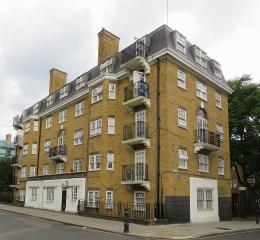
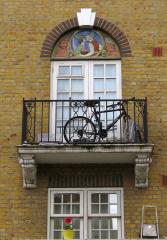

Sidney Street Estate, Somers Town, sculpture by Gilbert Bayes.
Sidney Street Estate, Somers Town, sculpture by Gilbert Bayes.


To the north of Euston Station is Somers Town, named from a great landowner of the 18th Century, and here is an interesting sculptural scheme by the eminent sculptor Gilbert Bayes on a housing estate. It is easy to find – looking from Euston Road, the road on the right hand of Euston Station is Eversholt Street, and proceeding north along this for a few minutes, there is a fine church on the right opposite Barnby Street. Turn right along Aldenham Street by the side of the church, and the second block along, bounded by Chalton Street, Bridgeway Street, Werrington Street and Aldenham Street itself, is the Sidney Street Estate – Sidney Street itself was obliterated by the housing development, which was put up by the St Pancras House Improvement Society and completed in 1938, replacing slums. Ian Hamilton was the architect. The blocks themselves are utilitarian things of yellow stock brick, but the sculpture is worthwhile. It consists of a number of half-roundels or lunettes above some of the balconies of the zig-zagging blocks, with high relief figural glazed pottery designs, little finials, of ships, en ronde – there is a nautical theme throughout – and a few other things.
The Little Mermaid relief sculpture.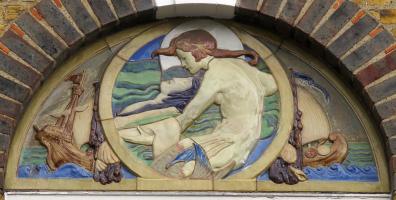
The half roundels or lunettes first: they show scenes from fairy tales, each based on a central circle with just a couple of figures, which fills the height of the lunette. To the sides, then, are roughly triangular shapes with two curved sides, one outwards, one inwards, to give two narrow points; these spaces contain further creatures or scenes. Gilbert Bayes was used to architectural sculpture, and aimed to make his pieces on a suitable scale to be seen from afar, emphasised by bright colours. The most evocative is the Little Mermaid, from the tale by Hans Christian Andersen, shown cradling the sleeping figure of her Prince so he does not slide into the water and drown; her own head is surrounded by the moon like a halo; the work is almost Symbolist. To the sides, we can see the front and back of a ship, or rather two different types of ship, curly waves, and seaweeds.
The design with a queen and what looks like two swans is not Leda and the Swan, but the Goosegirl, from Grimm’s Fairy tales, and shows the princess sitting, bowed forward, one goose – it does look more like a swan – with a crown around its neck, and the other behind her, with a small crown on its head. The princess’s hair, in blue against her white skin, is particularly effective. To the sides, flowers and an exotic palace or castle.
The Sleeping Beauty, from Grimm’s Fairy Tales again, shows the Prince in the act of unveiling the sleeping princess, who lies in a revealing shift, her head on a tasselled pillow, her hair confined by her crown. The Prince’s face rather lets down the image, the lines of his cheek and around the nose, mouth and chin being too soft, which I suppose was a necessary compromise to get the largeness of features to be seen from below, but does not work so well in close-up. To the sides, hanging bouquet again, and fierce, muscular dogs.
The Swineherd is back to Hans Christian Andersen, showing the eponymous young man, dressed pageboy style and a little effeminate of face, about to kiss the Princess of the fairy tale. The figures are well matched, each with a green hat, short hair, and occupying a similarly sized portion of the roundel. This piece shows best Gilbert Bayes excellent design sense – the almost symmetrical composition of the figures is nicely offset by her body and breasts facing a little towards the viewer, while his shoulder and back are what we see of the male figure. The hanging cloth from the Princess’s tall hat sweeps round to meet her elbow, the line continues around his enveloping lower arm, and then sweeps up via a curved cord to his hat, giving almost a circle which unites the figures. And the intense blue background is nicely divided up into almost equally sized fields, with none so large that it competes with the lighter-coloured figures. To the sides here are the swine, three great fat pigs in porcine repose, the lone one on the right twisted round to show his curly tale.
Another design shows St George and the Dragon, without roundel, and not shown here because when I went to take a photograph it was under scaffolding; likewise a clock with four figures of elves, depicting the Four Seasons.
Washing line post finials, also due to Gilbert Bayes.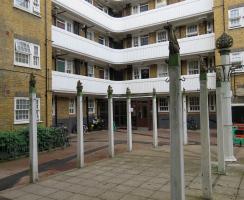

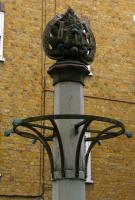
The finials to the washing line posts have small ships upon them, but alas, these are reproductions, the originals having been presumably stolen, and later on, turning up at auction, several appearing as recently as 2015. There used to be other finials – black birds, green fish with gasping mouths, muscular demons – all are gone. There remains a central Christmas tree finial, but this too would seem to be a reproduction.
Sydney Street Estate ironwork.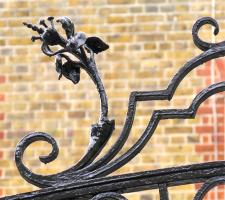
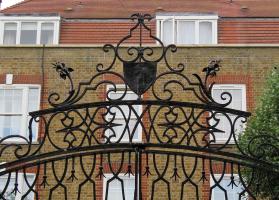
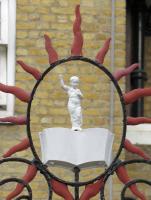
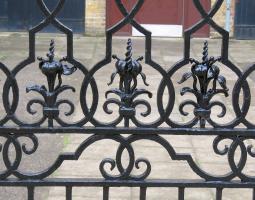
In a central arch is a statue of a Saint, with a horse behind him, dressed as a monk and carrying a sprig of white flowers and a small chest or perhaps book (see picture at top of page). A good placing, but glazed ceramic in the round on a small scale tends to look too sweet, less than sculpture and far less successful than the high relief lunettes. One of the gates has a very small figure of an young child standing on a book, within a sunburst, and the ironwork is generally interesting, with nice repeating floral designs. The out sides of the gateposts have ornamental supports with anchors and sharks in relief. And there is a blue plaque to the founder of the Association, Father Basil Jellicoe.
Gilbert Bayes, the sculptor, is best known for his Queen of Time, the Selfridges Clock (see this page). However, he made a range of architectural, coloured reliefs, and an example is shown below. Some of his exhibition pieces took similar conceptions, with small, solid works on bases similar to finials. And also to be mentioned are a set of chess pieces he made, including one piece similar to the Sidney Street ships, below left.
A little to the east of the Sidney Street Estate is Old St Pancras Church, with significant memorials, and in the surrounding churchyard, the monument to the architect John Soane, and the Burdett Coutts Memorial Fountain.
Visits to this page from 21 June 2016: 7,373